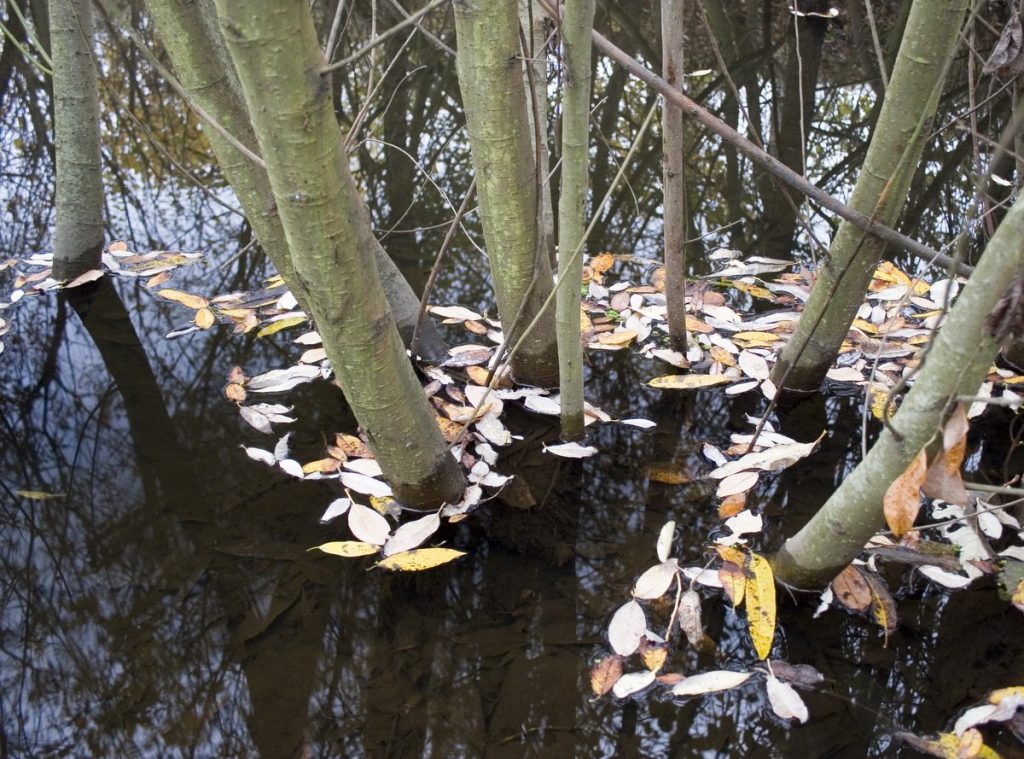Early Autumn
September 23 to November 5
The beginning of Leaf Fall is marked by the Autumn Equinox, Neo-pagans call it Maban, Persian Mehregan, and nearby is the Chinese lunar mid-autumn festival. Nights will be longer than days for six months. Leaf Fall gives way to Frost half way to the Winter Solstice, around the traditional festivals of Holloween, Samhain, and All Saints Day.
This is the end of the growing season of the Eight Season Year. The rains return in earnest, and the ground is thoroughly wetted again, and the cyclonic storms begin their rhythmic tumble off the Pacific. Towards the end of leaf fall, the big-leaf maples drop their floppy load of wet leaves, putting the forest to bed for winter.
Wild Creatures and Wildcraft
 With the rains, fall-running salmon that have been holding near stream mouths all over Puget Sound begin to return, first to the larger rivers, then to streams. The nights become cold, and fog clogs the morning. The first tentative frosts usually comes sometime in leaf-fall and the orb-weaver spiders collect dew on their webs.
With the rains, fall-running salmon that have been holding near stream mouths all over Puget Sound begin to return, first to the larger rivers, then to streams. The nights become cold, and fog clogs the morning. The first tentative frosts usually comes sometime in leaf-fall and the orb-weaver spiders collect dew on their webs.
Deer hunting season is declared in the public and private forest lands. Bulbs and roots fattened by summer sun are ready to dig. The warm rain on wet ground brings forth the fungal bloom. Chantrelle mushrooms are one of the prides of Cascadia. We rarely venture out without some kind of rain gear.
REVegetation
With cool temperatures and moist ground, the out-planting season begins. Potted stock are ready to go, and deciduous stock can be made bare-root as soon as leaves fall. Stools and layers are severed and moved. Perennials gone dormant may reveal their location, aiding their division. Bare-root nurseries won’t ship until next season, and in busy years, orders should have been placed back in summer, but those who have developed local propagation gardens can begin revetation.
Seeds scattered in summer swell in the rain and morning dew, and if uninhibited by some kind of biochemical delay, germinate in a flush of seedlings. Many will lay low with a couple leaves, until spring, with roots pushing down to gain a head start over spring geminants. Grasses and meadows that went dormant in the drought may put out a last flush of fresh leaves. It is likely too late to gather seed.
THE Garden
The garden is put to bed for winter and the incessant watering of summer finally comes to a close in a cool blanket of oceanic moisture. Winter crops come into their full form, even as they slowly slow new growth as the darkness approaches. Everything remaining outside is gathered in. Winter squash, apples and pears, potatoes. Roots are covered in mulch. Even under plastic the last tomatoes stagger to a green and orange finish, ending up on the kitchen windowsill. A green fuzz of cover crops is mixed with winter germinants like chickweed and stray mustards. The last few seeds are are sown, mostly those with the most robust germination like winter rye or hairy vetch. Fall planted bulbs from garlic to tulips are replanted under mulch. Anything left bare is finally slathered in maple leaves.
Earthworks and Construction
All earthwork with machines must be complete or potentially face a nightmare of mud and erosion. Cold-germinating grasses like annual ryegrass are used to stabilize cut earth. The ravages of earth moving machines are now tended to with mulch, from straw mulch to hog fuel to ramial chips. Seeding and out-planting begins.
The first rains reveal new pathways for concentrated flow, that may require more aggressive erosion control. The ground now moist is more yielding to hand work with shovels. As soon as leaves drop, and even before, species like willow, whips and cuttings are harvested, bundled, buried, staked and woven to slow the flow of water and stabilize stream banks.
Hazards
The rains finish the fire season and remind us of flood season. Emergency managers from FEMA, State Military, and Counties gather in the river floodplains and rehearse their plans for when the first big storms return.
Politics and Government
This is the heart of election season: mailings, robo-calls, door knocking, corner-sign-waving. Candidates speak boldly in vague language, and few difficult decisions are made by sitting officials facing re-election. Out of public view, various constituencies and stakeholders are preparing for legislative session, comparing notes, developing direction, and waiting to hear what the elections bring. Seeds are organized and planted, for the window for preparing legislation is short, between elections and the holiday season.
By the end of Leaf Fall, the governor’s agency budgets are available in bits and pieces, including various draft project lists and priorities, all getting dressed up for the benefit of legislators, as they consider the priorities of the State of Washington.
Federal budgets are typically in limbo, with a new fiscal year underway, but rarely does congress actually pass a budget until after elections. Various fiscal and strategic gymnastics are common for this shoulder season, as agency leadership tries to read the tea leaves of congressional processes, and programs encourage their stakeholders to educate you elected officials.
Previous: Harvest
Next: Frost
This post is part of a standing body of work to capture the seasonal nature of our lives, and how they might apply to the work of the Ecosystem Guild and Restoration Camping.


